If you’ve ever had the chance to lay back and watch hummingbirds swoop, hover, and zip around a feeder, you know how acrobatic these birds can be. Add to that their bright coloring which sometimes looks as if it’s sparkling in the sunlight, and you have a pretty incredible bird to watch.
Plus, most species aren’t afraid to visit feeders, so they aren’t that difficult to see. You can draw them into your yard and enjoy the show.
There are eight hummingbird species that hang out in Nebraska, so you have lots of opportunities to see different kinds.
Here is the list of species of hummingbirds in Nebraska:
- Ruby-Throated Hummingbird
- Anna’s Hummingbird
- Black-Chinned Hummingbird
- Calliope Hummingbird
- Broad-Tailed Hummingbird
- Rufous Hummingbird
- Costa’s Hummingbird
- Broad-Billed Hummingbird
8 Types of Hummingbirds in Nebraska
Hummingbirds visit every part of North America, but not every state sees all 16 of the species. Nebraska is visited by eight different species and a few of them are only rare visitors.
1. Ruby Throated Hummingbird
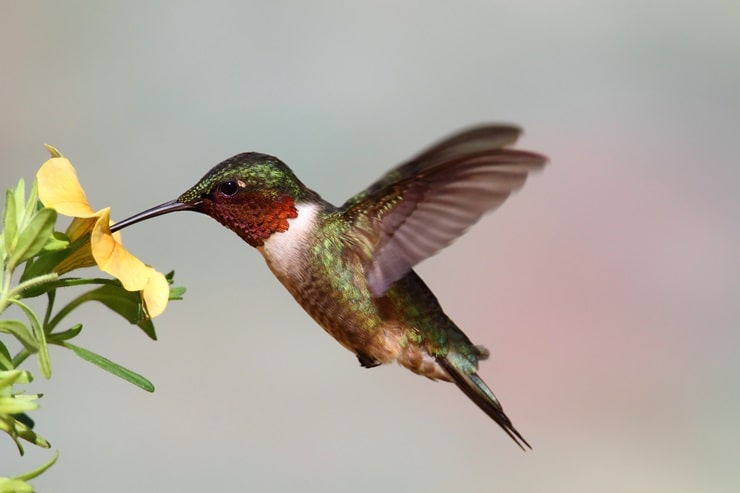
- Scientific name: Archilochus colubris
- Size: 2.8-3.5 inches long
- Weight: 0.1-.02 ounces
- Wingspan: 3.1-4.3 inches
Say “hello” to the most common hummingbird in Nebraska. In fact, this is the only breeding hummingbird in the eastern part of North America, and the only non-migratory hummingbird in the state. That means they nest in Georgia, but no other hummingbirds do.
The male birds are easy to identify by their bright red throats. If you notice a bird that looks somewhat like a ruby-throated hummingbird, but the throat looks dark red, it’s likely just because the feathers aren’t in good light. Wait until the sunlight hits them and you’ll see that shining bright throat.
Otherwise, these birds are emerald or golden-green on their backs and grayish-white on the underside. The beaks are black.
These bold birds are frequent visitors to feeders and if you have the chance to watch their antics, take it. They are incredibly agile. They can stop instantly in the air, hover up, down, side-to-side, and backward. Not only do they feed at feeders and in tubular flowers, but they’ll snatch insects out of the air or from webs, as well.
These generalists live in parks, gardens, backyards, meadows, fields, forests, and woodlands.
They fly away in the fall to winter in Central America and they actually fly across the Gulf of Mexico in one single flight without stopping. Very impressive!
When Do They Arrive In and Leave Nebraska?
This is the most common hummingbird in Nebraska and you can find them frequently from May until October.
2. Anna’s Hummingbird
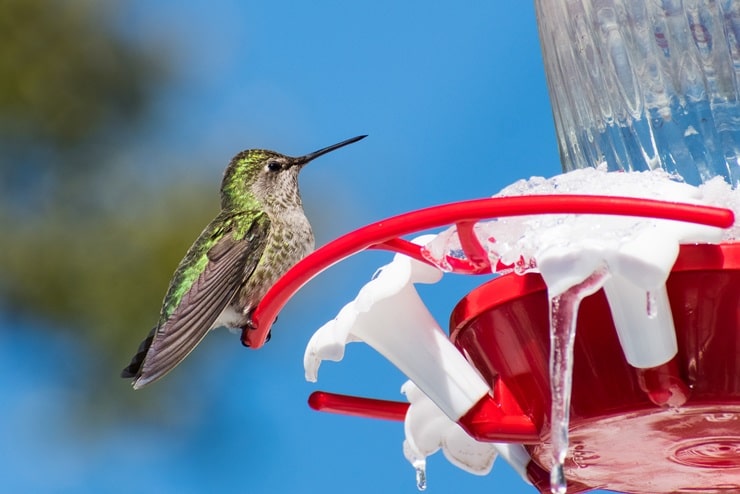
- Scientific name: Calypte anna
- Size: 3.9 inches long
- Weight: 0.1-0.2 ounces
- Wingspan: 4.7 inches
These pretty birds are common in the western part of the US and some stick around all year while some will migrate to Mexico during the non-breeding season.
Look for the greenish-gray birds with iridescent feathers. Males have reddish-pink chins and heads.
When they’re breeding, the males will swoop down up to 130 feet, making a buzzing noise with their tail feathers in an attempt to impress the females.
These birds are bold and curious and will come right up to humans to check them out. They’ll eat at feeders, snatch insects, and suck the sap of tubular flowers.
When Do They Arrive In and Leave Nebraska?
Anna’s hummingbirds are super rare and have only been spotted a few times. They like to visit feeders so look for them there during the summer.
3. Black-Chinned Hummingbird
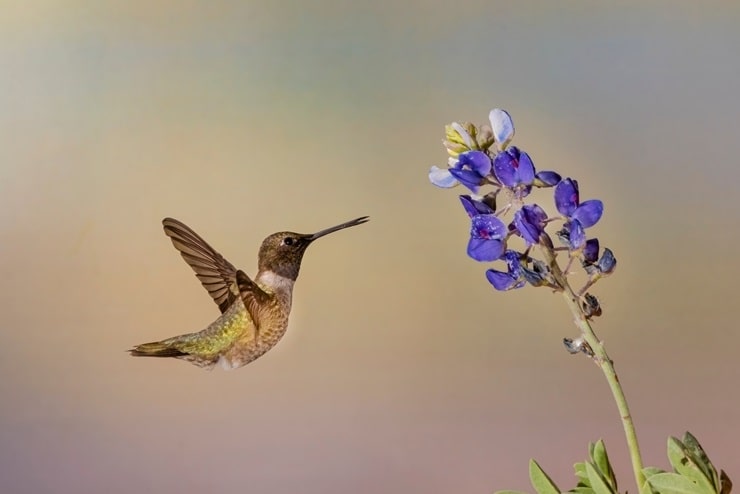
- Scientific name: Archilochus alexandri
- Size: 3.5 inches long
- Weight: 0.1-.02 ounces
- Wingspan: 4.3 inches
Black-chinned hummingbirds get their name from the black throat with an iridescent purple base that males have. Females, on the other hand, have pale throats, along with white tips on their outer tail feathers.
Some hummingbirds stand out because of their brilliant coloring, but black-chinned are just a bit more subdued. They only have a thin strip of iridescent purple on the chin, but otherwise, they’re dull metallic green with a dull grayish-white breast. Females have pale throats and males have black throats. Both have black bills.
These petite birds are frequent visitors to hummingbird feeders, where they dart in and out taking deep sips. They also sit on top of telephone wires and treetops to survey their territory. If a wandering hummingbird tries to enter their territory, the original bird will chase them off. Males can even dive up to 100 feet at a time to defend their territory and show off to females during breeding time.
They live anywhere they can find a safe spot to nest, which makes them generalists. They might live in a forest, a desert, or in urban shrubs. Recent surveys show that their range has been shrinking, with populations in Louisiana and Wyoming becoming threatened.
Breeding season starts in the early spring and they build their nests in April and May, with a second nesting period in July. The males court the females with dramatic diving displays and they breed throughout western North America. They’ll also visit the Gulf Coast during the winter. They nest in the spring and are one of the more common hummingbirds to find in their native range.
These are frequent visitors to feeders and they’ll snag any insects they find nearby, including ants that hang out on your feeder. They also eat the sap from flowers.
Hang a feeder in your yard to increase your chances of seeing them, and plant their favorite foods, including tree tobacco (Nicotiana glauca), scarlet larkspur (Delphinium cardinale), and desert ocotillo (Fouquieria splendens).
When Do They Arrive In and Leave Nebraska?
Black-chinned hummingbirds are accidental or rare in Nebraska from spring until fall.
4. Calliope Hummingbird
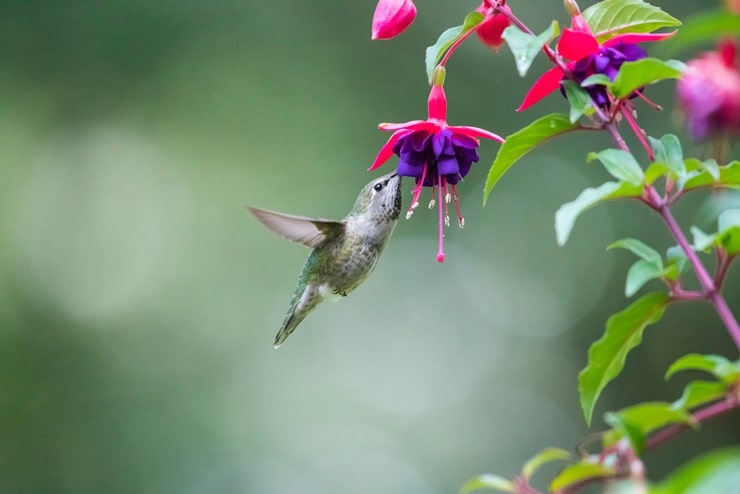
- Scientific name: Selasphorus calliope
- Size: 2.8-3.9 inches long
- Weight: 0.07-0.1 ounces
- Wingspan: 4.3 inches
Calliope hummingbirds are common in the Pacific Northwest, California, parts of the west, and Canada.
They breed in western Canada, Oregon, Washington, California, Nevada, Idaho, Nebraska, Wyoming, and parts of Utah and they spend the non-breeding season in Mexico.
The males of these beautiful birds have magenta feathers on their throats and both females and males have iridescent green feathers on their backs. The male courts the female by diving in an acrobatic u-shape while making a buzzing sound with his tail feathers. They breed from April to June.
While they will eat from feeders, they tend to be a bit more timid than some other hummingbirds. They aren’t afraid of other birds, though. They’re even known to chase away red-tailed hawks.
They’ll eat the sap from flowers, but they’re also fond of the sap on trees left by sapsuckers and they’ll also eat insects and spiders.
When Do They Arrive In and Leave Nebraska?
These tiny birds, the smallest hummingbirds in North America, might arrive in the summer and stick around through fall in Nebraska.
5. Broad-Tailed Hummingbird
- Scientific name: Selasphorus platycercus
- Size: 3.3-3.8 inches long
- Weight: 0.13 ounces
- Wingspan: 5.25 inches
The broad-tailed hummingbird is easy to confuse with the ruby-throated hummingbird. They look very similar.
These birds mostly live throughout the Rocky Mountains in high mountain meadows. Because they live in regions that experience hot days and cold nights, they’ve adapted by slowing their heart rate and lowering their body temperature at night and then ramping back up during the day when the sun rises.
They love to visit feeders or visit pendulous flowers to suck the nectar. Watch out, though. They’re extremely aggressive and will chase off any birds that come into their area.
When Do They Arrive In and Leave Nebraska?
Broad-tailed hummingbirds are often mistaken for ruby-throated hummingbirds in Nebraska. They can only be found during the summer. They’re considered an occasional but regular visitor.
6. Rufous Hummingbird
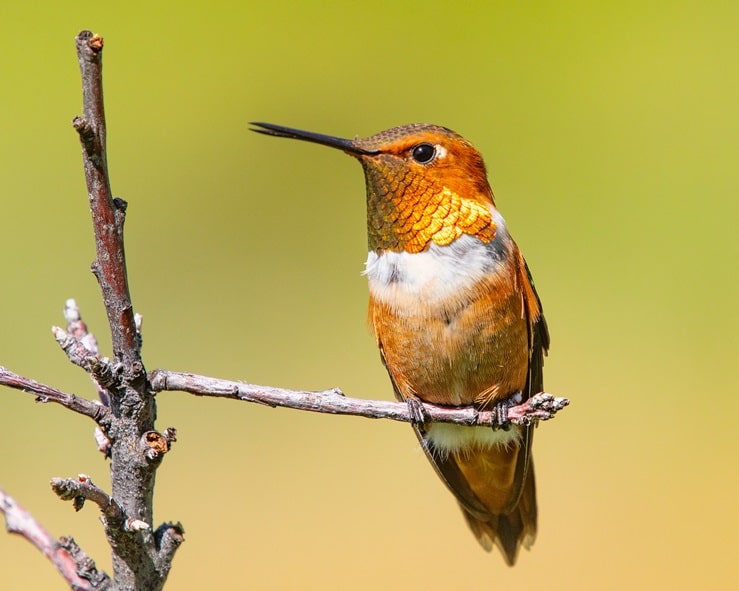
- Scientific name: Selasphorus rufus
- Size: 2.8-3.5 inches long
- Weight: 0.1-.02 ounces
- Wingspan: 4.3 inches
Rufous means “reddish” and that’s what these birds are. When the sunlight hits them, they glow like a lump of burning coal, with a reddish back and a vivid red throat. The females have a little bit of green on their tails and flanks, plus a little spot of orange on their throats.
Even though these birds might just be visiting an area as they migrate, they’re fierce defenders of the area they are in. They will tirelessly chase off any hummingbird that dares come near. They’ll even chase off bigger birds of other species and they’ll dive-bomb humans who come too close to their feeder or nest.
Like ruby-throated hummingbirds, they’re incredibly agile and will feed from feeders and tubular flowers, as well as snatch insects from the air or spider webs. They live in backyards, forests, meadows, and parks.
In the spring, they leave for their breeding grounds on the west coast where they stay from April to July.
When Do They Arrive In and Leave Nebraska?
These hummingbirds are considered rare and threatened in Nebraska. Look for them in wildlife areas from June through September.
7. Costa’s Hummingbird
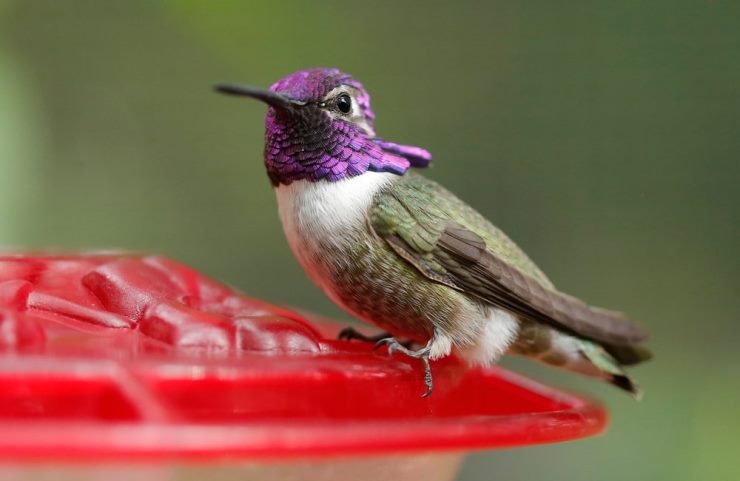
- Scientific name: Calypte costae
- Size: 3.5 inches long
- Weight: 0.1 ounces
- Wingspan: 4.3 inches
These compact little birds appear to have a sort of hunched posture. The adult males have a purple crown and neck, with a green back and sides.
These birds feed on chuparosa and ocotillo, as well as insects and at feeders. They live in desert areas of the American west. You mostly find them in Southern California, Nevada, parts of Utah, and a little bit of New Mexico, but they do migrate so you might see them as far east as Florida and as far north as Alaska.
They breed in the interior of the country but stay on the coast year-round. During the non-breeding season, some might visit coastal Mexico.
These birds are shyer and will avoid feeders if bolder, more aggressive species are there.
When Do They Arrive In and Leave Nebraska?
Costa’s hummingbirds aren’t common in Nebraska. They’re rare visitors that you’ll have to watch carefully for. A sighting hasn’t been recorded for several years.
8. Broad-Billed Hummingbird
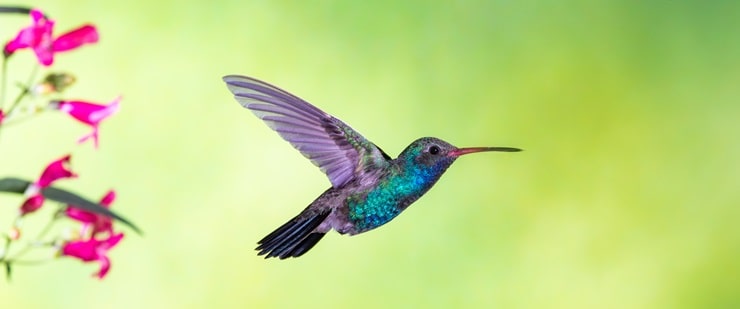
- Scientific name: Cynanthus latirostris
- Size: 3.5 inches long
- Weight: 0.1 ounces
- Wingspan: 4.3 inches
The broad-billed hummingbird makes Mexico and a few parts of the Southern US such as Arizona and New Mexico its home. It stays year-round in Mexico, but ventures further north during the breeding season.
This bird has a long, narrow, straight bill and a tail with a notch at the center, which helps you tell it apart from other species. They also stand out because of their shimmering green bodies and blue throats on the males. The bills are red with a black tip.
They eat insects as well as the nectar from flowers and feeders.
These birds create their nests in mountain canyons and then head to higher elevations to forage after raising their young. The males court the females with a swooping display that has been compared to the swinging of a hypnotist’s watch.
There are five sub-species but only the magicus sub-species lives in the US.
When Do They Arrive In and Leave Nebraska?
These hummingbirds have only rarely been identified in Nebraska, but if they do visit, it’s in the summer.
How to Attract Hummingbirds
Hummingbirds are a New World group of birds, meaning they only live in South, Central, and North America. Within North America, there are 16 native species of hummingbirds and a few visiting species.
If you want a sure-fire experience of drawing birds to your yard, try hanging up a hummingbird feeder. Hummingbirds travel far and wide to find good food and they’ll stop by and eat the food in your feeder, giving you an exciting show in the process.
To attract hummingbirds to your yard, pick feeders that have a little perch so you can observe them holding still as well as in flight.
Contrary to common belief, the feeder doesn’t have to be red. These birds don’t care about the color, they just want a nice meal. You can grab a beautiful feeder with perches from Bolite. Don’t die the nectar, either. Clear nectar is totally fine.
You can also use pre-made nectar to attract them. Just be sure to change the nectar frequently and wash the feeder out with hot water and soap. When it’s really hot, you should change your feeder daily. During cooler weather, once a week is fine.
Feeders left uncleaned develop a mold that can kill hummingbirds.
Some experts also recommend that you put your feeders away in regions that get cold during the winter so you don’t accidentally entice tropical birds to stick around during the winter.
You should also plant stuff like firebush, fuchsia, honeysuckle, cardinal flowers, fire pink, wild bergamot, columbine, red buckeye, trumpet vine, and powder puff trees. Hummingbirds love these.
Other Species of Birds in Nebraska:
Woodpeckers in Nebraska
Owls in Nebraska
